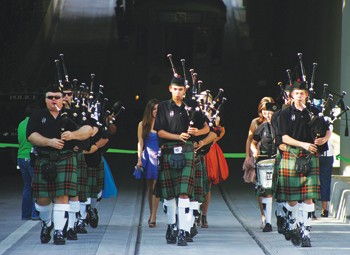The Fourth Avenue underpass is hailed as an incredible achievement by more than one onlooker, all sweating conspicuously now, because the air is stifling from so many bodies packed together. Ideally, it won’t be the case at future events, I’m told, because the east-facing walkway was deliberately designed speciously wide, apparently to accommodate street fairs ad infinitum. The actual unveiling of the underpass is symbolically eclectic, but what’s being symbolized isn’t all that clear. On one hand we’re all gathered to celebrate a finished roadway and the vast commercial benefits a new and direct thoroughfare to downtown Tucson will provide. On the other hand, we’re basically honoring the idea of the underpass, and what said idea actually is, is nebulous and weirdly exemplified.
A troupe of bagpipers leads the parade, playing in regimented unison with what look like Scottish “”Great Highland”” bagpipes and one guy thumping a huge bass drum. Everyone around me says they’re here because some official founder of Tucson was Irish, but no one knows his name.
Five or six models for some designer whose business is going to get way better now that there’s easy access walk behind the bagpipers, all dressed and smiling prettily along the center shoulder while the musicians take a water break. The trolley follows shortly after, and the speakers clamor out in suits, all well-to-do and important members of the Tucson community (including UA President Robert Shelton and Mayor Bob Walkup) and the trolley driver, who actually gets the biggest reaction from the crowd after his speech.
The problem is that the acoustics in the big new underpass actually suck, and unless you’re one of the fortunate few jammed into plastic patio chairs right in front of the speaker system, most of the speeches sound like magnified indistinctiveness. I definitely caught “”achievement,”” “”testament,”” “”good things don’t come to those who wait, they come to those who struggle”” and, from the same speaker, “”a great city is one that admits it’s wrong.”” I also joined in singing “”Happy Birthday”” to Tucson.
Fruits of the Tucson Portrait Project are there, too, in a small space on the northwestern side of the walkway. The most distinctive part of the display are the red dots taped to certain tiles, justified by a disclaimer to the right saying that they are either the incorrect image or are damaged, and will be replaced immediately. Weird little exclamatory stuff like this is pervasive in the underpass right now, since a lot of things — like the Portrait Project — aren’t quite finished, but that’s not to say they aren’t finished enough, at least, to be celebrated as a citywide, communal achievement. Then again, if it’s the building of a “”historic bridge”” or “”communal walkway”” being celebrated here, rather than just the completion of an underpass, maybe they should have taken the extra time to get things 100 percent finished.
To be fair though, we’re all told multiple times to “”support local businesses”” throughout the speeches, and I was handed a couple of fliers for events happening downtown the very same evening. So at least the powers that be understand the actual reasons why the underpass is important — again, connecting the massive Fourth Avenue and UA crowd with revitalized downtown businesses. But the extent of emphasis placed on the underpass itself, rather than the function it provides, is still odd.
The symbolism here is meant to imply that the underpass is a bridge between past and present Tucson, just as much as it connects the older part of the city with the new. In truth, anyone who has taken a walk or even just driven through the Sixth Street underpass, or pretty much any underpass in an urban area like Tucson, might wonder just how long symbolic ornamentation can be maintained. Yes, we have graffiti-proof finish now and better lighting and space, but whether that, and the initial sense of communal victory, was worth the extra time deterring businesses which needed easy access to downtown, and whether it will retain its polish or effect remains unclear.









